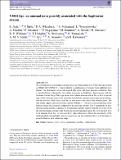Files in this item
V5852 Sgr : an unusual nova possibly associated with the Sagittarius stream
Item metadata
| dc.contributor.author | Aydi, E. | |
| dc.contributor.author | Mróz, P. | |
| dc.contributor.author | Whitelock, P. A. | |
| dc.contributor.author | Mohamed, S. | |
| dc.contributor.author | Wyrzykowski, Ł. | |
| dc.contributor.author | Udalski, A. | |
| dc.contributor.author | Vaisanen, P. | |
| dc.contributor.author | Nagayama, T. | |
| dc.contributor.author | Dominik, M. | |
| dc.contributor.author | Scholz, A. | |
| dc.contributor.author | Onozato, H. | |
| dc.contributor.author | Williams, R. E. | |
| dc.contributor.author | Hodgkin, S. T. | |
| dc.contributor.author | Nishiyama, S. | |
| dc.contributor.author | Yamagishi, M. | |
| dc.contributor.author | Smith, A. M. S. | |
| dc.contributor.author | Ryu, T. | |
| dc.contributor.author | Iwamatsu, A. | |
| dc.contributor.author | Kawamata, I. | |
| dc.date.accessioned | 2016-07-21T11:30:07Z | |
| dc.date.available | 2016-07-21T11:30:07Z | |
| dc.date.issued | 2016-09-11 | |
| dc.identifier | 244442159 | |
| dc.identifier | 0a5f8044-cf46-4ace-9e46-0d6131343ecd | |
| dc.identifier | 84982311613 | |
| dc.identifier | 000383273600028 | |
| dc.identifier.citation | Aydi , E , Mróz , P , Whitelock , P A , Mohamed , S , Wyrzykowski , Ł , Udalski , A , Vaisanen , P , Nagayama , T , Dominik , M , Scholz , A , Onozato , H , Williams , R E , Hodgkin , S T , Nishiyama , S , Yamagishi , M , Smith , A M S , Ryu , T , Iwamatsu , A & Kawamata , I 2016 , ' V5852 Sgr : an unusual nova possibly associated with the Sagittarius stream ' , Monthly Notices of the Royal Astronomical Society , vol. 461 , no. 2 , pp. 1529-1538 . https://doi.org/10.1093/mnras/stw1396 | en |
| dc.identifier.issn | 0035-8711 | |
| dc.identifier.other | BibCode: 2016arXiv160602755A | |
| dc.identifier.other | ORCID: /0000-0002-3202-0343/work/75996719 | |
| dc.identifier.uri | https://hdl.handle.net/10023/9186 | |
| dc.description.abstract | We report spectroscopic and photometric follow-up of the peculiar nova V5852~Sgr (discovered as OGLE-2015-NOVA-01), which exhibits a combination of features from different nova classes. The photometry shows a flat-topped light curve with quasi-periodic oscillations, then a smooth decline followed by two fainter recoveries in brightness. Spectroscopy with the Southern African Large Telescope shows first a classical nova with an Fe II or Fe IIb spectral type. In the later spectrum, broad emissions from helium, nitrogen and oxygen are prominent and the iron has faded which could be an indication to the start of the nebular phase. The line widths suggest ejection velocities around 1000 km s-1. The nova is in the direction of the Galactic bulge and is heavily reddened by an uncertain amount. The V magnitude 16 days after maximum enables a distance to be estimated and this suggests that the nova may be in the extreme trailing stream of the Sagittarius dwarf spheroidal galaxy. If so it is the first nova to be detected from that, or from any dwarf spheroidal galaxy. Given the uncertainty of the method and the unusual light curve we cannot rule out the possibility that it is in the bulge or even the Galactic disk behind the bulge. | |
| dc.format.extent | 10 | |
| dc.format.extent | 1923177 | |
| dc.language.iso | eng | |
| dc.relation.ispartof | Monthly Notices of the Royal Astronomical Society | en |
| dc.subject | Binaries: close | en |
| dc.subject | Novae, cataclysmic variables | en |
| dc.subject | White dwarfs | en |
| dc.subject | QB Astronomy | en |
| dc.subject | QC Physics | en |
| dc.subject | NDAS | en |
| dc.subject.lcc | QB | en |
| dc.subject.lcc | QC | en |
| dc.title | V5852 Sgr : an unusual nova possibly associated with the Sagittarius stream | en |
| dc.type | Journal article | en |
| dc.contributor.institution | University of St Andrews. School of Physics and Astronomy | en |
| dc.identifier.doi | https://doi.org/10.1093/mnras/stw1396 | |
| dc.description.status | Peer reviewed | en |
| dc.identifier.url | http://adsabs.harvard.edu/abs/2016arXiv160602755A | en |
This item appears in the following Collection(s)
Items in the St Andrews Research Repository are protected by copyright, with all rights reserved, unless otherwise indicated.

